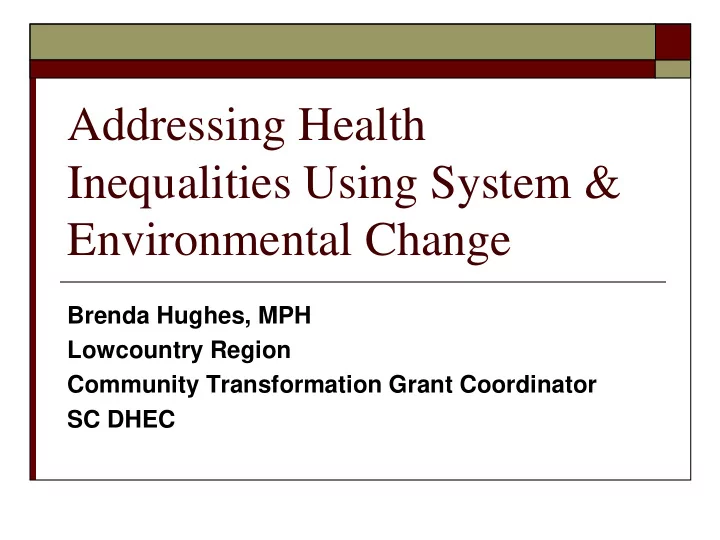

Addressing Health Inequalities Using System & Environmental Change Brenda Hughes, MPH Lowcountry Region Community Transformation Grant Coordinator SC DHEC
Overview Community Engagement Systems and Environmental Change Health Inequalities Context Systems and Environmental Change in Action Lessons Learned
Why Community Engagement? Community members are the experts Sense of ownership of problems and solutions Empowerment Enhanced sustainability
Community Engagement Dynamic relationships & dialogue Mutual exchange of information, ideas, resources between the community and public health experts Community includes individuals, groups, organizations, associations, informal networks who share common characteristics, interests, concerns Source: Morgan, M., Lifshay, J. (2006) Community Engagement in Public Health, Contra Costa Health Services
Making the Case: Programs vs. System and Environmental Change Programs System/Environment Usually one time, short- Ongoing impact at the term interventions at organizational or the individual level community level Short-term changes Produce behavior change over time Sustainable May not be sustainable
Health Inequalities Differences in: Environment Access to, utilization of, and quality of care Health Status A particular health outcome deserving of scrutiny Source: Pokras, O., Baquet, C. (2002). What is a health disparity. Public Health Reports, 117 . 426-434. Health disparities persist despite significant advances in science (i.e. behavioral science, medicine, genomics, etc). Source: Mullan, I., Rhee, K., Stoff, D., Polhaus,H., Sy, Francisco., Stinson, N., Ruffin,J (2010), Moving Toward Paradigm-Shifting research in health disparities through translational, transformational and transdisciplinary approaches. American Journal of Public Health 500(1). 19-24.
Health Inequalities Non-biological factors contribute to poor health in populations most affected by health inequities Residents of rural areas, ethnic and racial minorities, low socioeconomic status disproportionately affected by obesity A balance between evidence-based strategies, community engagement, systems and environmental change is necessary to improve health outcomes and address disparities. Source: Mullan, I., Rhee, K., Stoff, D., Polhaus,H., Sy, Francisco., Stinson, N., Ruffin,J (2010), Moving Toward Paradigm-Shifting research in health disparities through translational, transformational and transdisciplinary approaches. American Journal of Public Health 500(1). 19-24.
Context County Poverty Obese Sedentary <5 F/ V Hospital Costs Beaufort 12% 65% 21% 80% 86,653,100 Colleton 23% 67% 37% 86% 31,895,400 Hampton 25% 78% 22% 83% 13,837,300 Jasper 25% 67% 25% 80% 1,074,200 Orangeburg 25% 73% 29% 83% 96,479,700
Systems and Environmental Change in Action Promote Smoke-Free Environments Worksite Wellness Increased Access to Physical Activity Increased Access to Healthy Food
Smoke-Free Environments: Hampton, Estill, Yemessee
Worksite Wellness: Beaufort Jasper Water Authority Working Well/BJWSA Considering expansion of the current smole-free policy into a tobacco-free, property-wide policy A community-supported agriculture (CSA ) opportunity has been created. Fresh fruits and zero calorie beverages in their break rooms Creating a 1-mile walking trail, marked with signage, and potentially maps at their administrative site. Including employee wellness into their organization’s strategic plan and the creation of an employee wellness and safety committee
Worksite Wellness: Orangeburg Tobacco- Working Well Orangeburg County School District 5 realigned their policies and procedures related to all tobacco and nicotine products, All Tobacco-related signage has been updated. Tobacco cessation posters, identifying free resources, are in place in all schools/district buildings. School nurses provide tobacco cessation awareness at schools and at the district office .
Physical Activity Hampton County Sidewalk Audits Walking Behavior Survey (n=229) Signage at Lake Warren, seasonal events Comprehensive Walking Plan (incl. Complete Streets principles) Partnering with local government and hospital to implement walking plan recommendations
Physical Activity Orangeburg Each elementary school provides scheduled PE classes for 80-90 minutes per week Encourage teachers to use recess for organized activities, walking, as well as “free play” Provide training in using movement to stimulate brain activity in conventional classroom settings Provide increased opportunities for those who work in offices to walk during lunch hour, etc.
Food Access Beaufort: Sheldon Township Faith-Based Consortium Community Garden Network 4 Gardens: Each Church supports 2 other churches Over 200 community members served at each site
Sheldon Township
Food Access Hampton County: Fennell Elementary Community Garden Garden has served approximately 500 community members in a 2 yr. period. Seedlings are used to sustain garden & are given to other schools in the county to promote & support gardening efforts.
Food Access Colleton County: 4 Community Gardens (2 schools, 2 neighborhoods) Over 100 lbs of produce distributed Seedlings are raised at a school garden and will be used to sustain the entire garden network
Community Garden Block Party
Food Access Jasper: Jasper County Neighbor’s United (JCNU). “Garden of Hope”, 2 schools More than 93 families served by harvest (JCNU) Master Gardener in residence (JCNU). Provides technical assistance to all gardens in Beaufort/Jasper network
JCNU
Lessons Learned Community Engagement is an ongoing process (levels of engagement change, staffing issues, interpersonal conflicts) Flexibility Community gardens are A LOT of work (but worth it!)
https://www.youtube.com/watch?v=rS-- SjfJH8c
Questions Brenda Hughes, MPH hughesbd@dhec.sc.gov 843.549.1516, ext 214
Recommend
More recommend